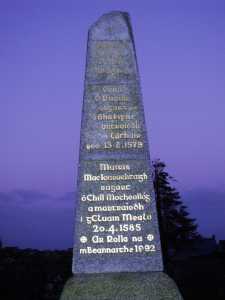|
On September 22nd 1992, Pope John Paul II beatified Bishop Patrick O'Healy,
O.F.M. and Conn O'Rourke, O.F.M. Both were Franciscans. It is believed
that O'Healy was a native of Dromahaire, County Leitrim and was born between
1543 and 1546. He spent his education in Rome, Paris and Spain. Pope Gregory
XIII appointed O'Healy as Bishop of Mayo in July 1576.
Later Bishop O'Healy was in Portugal where he met up with James Fitzmaurice,
who was trying to raise funds for a crusade to be sent to Ireland against
the English. The Bishop changed his mind about taking part in the expedition
but despite this, the English continued to assume that O'Healy was involved
in the plot.
Conn O'Rourke joined up with Bishop O'Healy when he was on his way back
to Ireland. It is thought that Conn originally came from Breifne, which
was in Connacht. They both arrived in Sligo from France at the turn of
1576-7. At his execution in 1579, O'Rourke was around 30 years of age.
He also entered the religious life at Dromahaire. Both sailed from Brittany
and landed in Smerwick. They went to Askeaton to meet the Earl of Desmond
but with the absence of the earl, they had an audience with his wife,
Eleanor instead.
Bishop O'Healy and O'Rourke set out for Connacht where they planned to
do some pastoral work via Limerick. However, Eleanor had informed the
English of their plans and they were captured in the city. They were then
transferred to Kilmallock where they were then imprisoned.
O'Healy and O'Rourke never received a trial as such but there underwent
several interrogations. O'Healy refused to acknowledge the Queen as the
Supreme Head of the Church and stated that the Pope held this title. For
this they were condemned to death. Bishop O'Healy was also tortured during
his stay in Kilmallock jail. Both were hanged in Kilmallock on the 13th
of August 1579. O'Healy was the first bishop to be killed by the English.

© Crochta monument
A sculpture memorial to these men, known as the Crochta memorial, was
erected in the grounds of Kilmallock church. This memorial is by Clíodhna
Cussen. It was unveiled on June 14th 1988 by Bishop Fiachra Ó Ceallaigh
and was erected in a fairy fort-like structure. Also remembered on the
memorial is Fr Maurice Mac Enraghty who was from Kilmallock. Fr Mac Enraghty
was chaplain to the Earl of Desmond and was captured in September 1583.
Mac Enraghty was imprisoned in Clonmel and in Easter 1585, Victor White,
a prominent Catholic in Clonmel arranged with the jailer that Mac Enraghty
could walk out of the prison.
However, the jailer went and told the authorities where they could seize
the main Catholics in the area. The following morning soldiers entered
the house of Victor White just as mass was about to be celebrated. Victor
White was arrested but Fr Mac Enraghty escaped. White was told that he
would be put to death unless he brought the priest to the authorities.
When Fr Mac Enraghty heard this he returned to Clonmel and turned himself
in. Under extreme pressure he refused to renounce his religion and was
executed in Clonmel on April 30th, 1585.
A native of Ballingaddy, John J. Flanagan won three Olympic Gold medals
in the games of 1900, 1904 and 1908 in the Hammer for the USA. At the
1900 Games in Paris, Flanagan threw 163 ft 1 ½ inches (49.73 metres)
which was an Olympic record. The hammer is said to have almost hit some
spectators, such was the length of the throw. At the next Games in St
Louis, Flanagan won the Hammer again throwing 168 ft 0 ½ inches
(51.23 metres), which was a new Olympic record. In 1908 in London he won
his third Gold medal in the Hammer throwing 170 ft 4 inches (51.92 metres),
another new Olympic record.


|